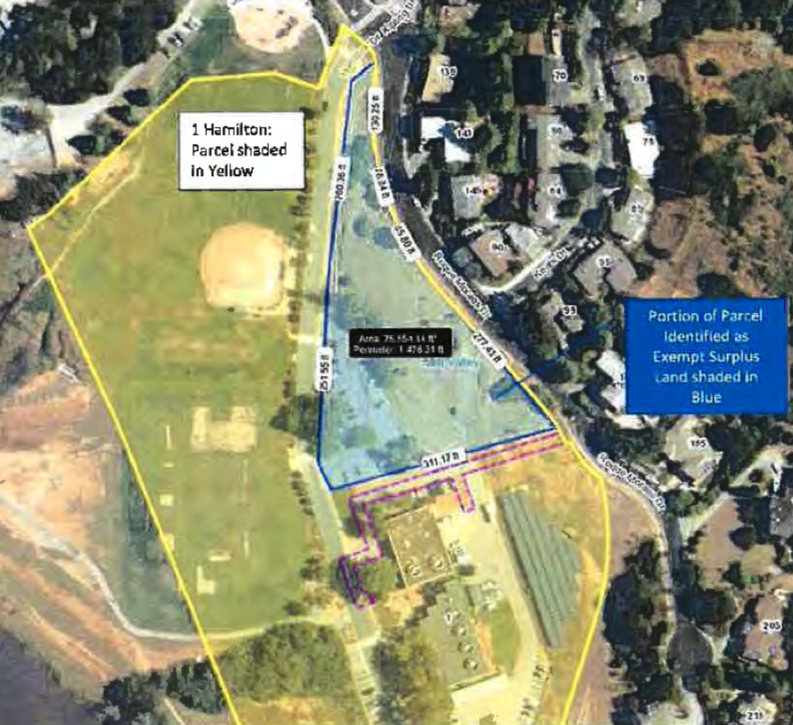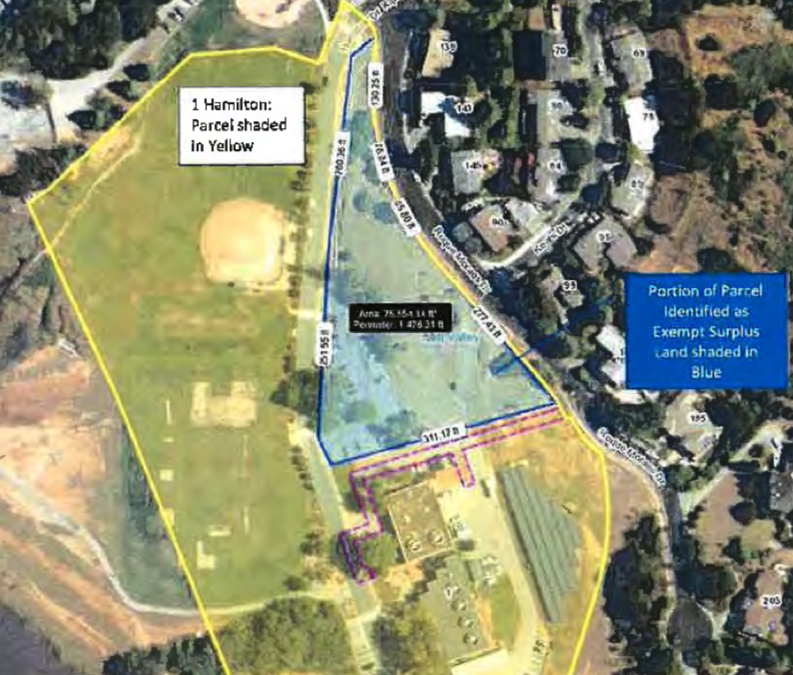
The portion of 1 Hamilton Drive shaded in blue is expected to be identified as exempt surplus land, a necessary legal step the City must take prior to entertaining proposals for the site.
Nearly three months after the Mill Valley City Council unanimously took steps toward creating more affordable living situations in town, particularly for the large number of people who work in Mill Valley but cannot afford to live here, the process continues Sept. 20.
City officials have identified a large piece of vacant land (above, and at left) at the northern edge of 1 Hamilton Drive, which houses the city’s Public Safety Building at the southern end of the parcel, as a possible site for affordable rental housing.
One of the key steps it intends to take on Sept. 20 is to declare the parcel’s northern portion as “exempt surplus land,” a legal step City officials say must be taken prior to entertaining proposals for the site. To take that step, the City must meet the following conditions:
Use at least 80 percent of the parcel for the development of housing; make at least 40 percent of the total number of those housing units developed on the parcel affordable to households whose incomes are equal to, or less than, 75 percent of the maximum income of lower income households, and at least half of which shall be affordable to very low-income households. Units designated for low or moderate income households must remain continually affordable to those individuals or families for at least 30 years.
The Council also must decide if it should select EAH Housing, the lone submission to the City’s RFQ (Request for Qualifications) for potential developer partners. “The small response to the RFQ is likely due to the size of the project, which is on the smaller side for affordable housing projects, and the recent influx of state funding available which has resulted in large work loads for affordable home builders,” City officials stated in a staff report.
Established in Marin in 1968, EAH has developed and manages more than 34 residential and mixed-use communities within Marin totaling nearly 1,000 rental apartments that house more than 1,700 low-income households in Marin, including 75 Shelter Hill affordable apartments.
If they do so, the Council would then authorize the City Manager to negotiate an Exclusive Negotiating Agreement (ENA) to establish the terms of the partnership for the potential lease or sale of property and development of affordable rental housing on the parcel.
The Sept. 20 hearing represents the next chapter of a contentious issue for residents of the neighborhoods surrounding the City-owned property, including Enchanted Knolls, Eucalyptus Knoll, Shelter Ridge, and others who concluded that a development on the site would be too large, too negatively impactful on traffic and parking and that the process has moved too quickly for residents who want more time to digest its impacts.
The hearing in June garnered more than four hours of vigorous discussion about the housing proposal, with petitions both for and against the proposal.
Neighbors have galvanized behind a “Save Hauke Park” campaign, despite no existing proposal to develop any portion of Hauke Park itself. City officials have also set a goal of increasing available public parking to 50 spaces as a potential benefit to the community, because this public parking is periodically in high demand, especially on weekends,” according to a supporting document posted in August.
Meanwhile, residents who want the City continue to make headway on diversity, equity and inclusion initiatives see the lack of affordable housing as a chance to create more opportunities for people who already contribute to our community in a variety of ways but aren’t able to live here because of the prohibitive cost of housing.
Senior Planner Danielle Staude and housing consultant Janet Smith-Heimer kicked off the June meeting with a presentation, laying out the “housing affordability gap” for those who work here but cannot afford to live here: “Currently an attainable level of rent for employees such as store clerks, teachers and physical therapists is in the range of $1,700 a month while the average market-rate, 2-bedroom unit in Mill Valley averages $2,700 a month to rent.”
“That results in a disconnect in our community,” Staude said. “We have a large proportion of people who work here and leave Mill Valley at 5pm, and their kids don’t likely go to school here, they don’t contribute to social activities or volunteer in the community.”
As District 3 Supervisor and former Mill Valley Mayor Stephanie Moulton-Peters said at the hearing in June, “Mill Valley is a community that builds affordable housing and we have many examples in town. Every neighborhood should contribute to affordable housing. I would offer up my Blithedale Canyon neighborhood. We are not a complete community anymore. We are in a time warp. We don’t have the people who need to be living here. I support this project.”
City officials have remained steadfast that while they have already implemented housing initiatives like accessory dwelling units (ADUs), which have created an average of 20 units around the city each year, and the Covia “House Mill Valley” home share program throughout town, there is much more to do. Smith-Heimer noted that the project, if it continues to move forward, wouldn’t likely open until at least 2025.
City officials have pushed back on the idea that “the train has left the station.” “The site needs to be able to park all of the cars, and we will enhance parking at the park,” Councilmember Urban Carmel said. “There will be a traffic study to make sure it does not make traffic worse.”
“A good developer will have a track record with dealing with these kinds of questions,” Mayor John McCauley added.
The EAH Housing team also made it clear during their interview with the selection committee that there are a number of construction/design strategies and building types that the EAH Housing team is interested in exploring with the community before settling on a design concept.
Once the Council adopts the resolutions, staff will present a draft ENA for final review and approval. Once the ENA is signed by both parties, which is anticipated to occur by the end of the year, the conununity engagement process will be kicked off for site planning and design of the project. Assuming the project proceeds forward, CEQA review would occur, and Council would later consider project entitlements and a DOA and/or ground lease (or sale) for disposition of the site and construction of housing.
The level of environmental review will be determined once the scope of the project is determined.
All of this work is happening as the City embarks on a new Housing Element for years 2023-2031, a long-term, state-mandated deep dive into the future of housing in our community. The process began this week amidst the City Council’s heightened focus on creating the framework for more affordable housing in Mill Valley, as well as the Association of Bay Area Governments’ Regional Housing Needs Allocation that calls for an eye-popping increase in the number of units to be planned for by the city, from 129 units in the 2014-2022 cycle to 865 units in the 2023-2031 cycle (the City has appealed that allocation).



Unless the rules have changed, all need to be aware that this housing cannot be saved just for MV workers and will be made available to anyone from anywhere in CA who fits the guidelines and applies for low cost housing.